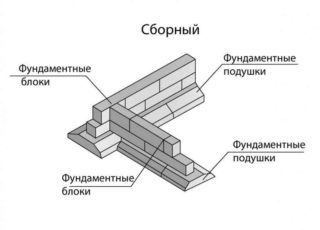A robust and stable support system is the key to a long and trouble-free operation of any building. Monolithic reinforced concrete foundation is deservedly considered the most reliable of the foundations existing today. The process of creating a structure is rather complicated and time consuming. However, knowing the technology of its construction, you can do this work yourself, saving a lot on the services of specialists.
Features and structure of a reinforced concrete foundation
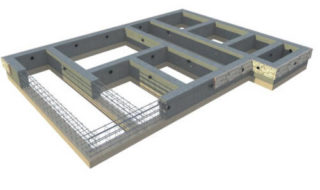
The reinforced concrete foundation is a strong and heavy structure designed for the construction of massive buildings. Such a base is designed for heavy loads and long service life in almost any environment. This is a closed system, immersed in the ground below its freezing point or a slab, which evenly distributes the mass of the building to the surface.
A structurally monolithic reinforced concrete foundation consists of the following elements:
- Substrate. Serves to cushion seasonal ground movements. It is made of sand and crushed stone, the layer height varies between 10-30 cm, depending on the size of the support system, the type of soil and the weight of the structure.
- Metal carcass. Accepts bending and twisting loads, giving the entire structure a single structure. The frame is made of reinforcement rods with a diameter of up to 16 mm, interconnected by wire or ties. The frames are flat and voluminous in shape.
- Concrete. The composition of the solution includes sand, cement, crushed stone, plasticizers and modifiers can be added. After hardening, concrete acquires the strength of a stone. It takes vertical and horizontal loads, protects the reinforcement from corrosion.
- External finishing. It is not a required structural element. As a rule, the reinforced concrete tape foundation is exposed to insulation and waterproofing, inside which the basement is equipped.
The basis for successful construction is the use of quality materials and scrupulous adherence to the laying technology. Untreated sand and crushed stone, expired cement and rusty reinforcement negatively affect the strength and durability of the reinforced concrete support system. The foundation device is simple, but it must be made correctly.
Varieties of reinforced concrete foundations
- National teams. The technology consists in laying in a pit with subsequent reinforcement of slabs or blocks. The work uses concrete products of independent or factory production. The method allows construction to be carried out quickly, while achieving a completely decent result, since the fixation of the elements is carried out on a cement mortar. However, you need to be prepared for the costs of freight transport and lifting equipment. Even the most compact FBS foundation block weighs about 300 kg. The mass of the slabs starts from 1500 kg. Therefore, the foundation strip prefabricated reinforced concrete is chosen when tight deadlines are at the forefront of construction.
- Monolithic. Filled structures are much cheaper than prefabricated ones, but they require much more time and effort to equip. An important advantage of such support systems is the ability to make them by hand.In addition, you will need to spend only on the delivery of material and the rental of a concrete mixer. In addition, the monolithic base has greater strength and reliability, since there are no joints in it, which are weak points. Also, concrete can be used to make a foundation of absolutely any complexity and configuration - not only with right angles, but also with broken and rounded lines.
An alternative, which can seriously reduce the construction cost estimate, is a driven pile or columnar foundation made of reinforced concrete. However, it should be taken into account that here, too, the involvement of special equipment will be required, and in the future, the installation of the grillage. Another disadvantage of the base of the glass-type supports is that a basement cannot be equipped under the house.
Advantages and disadvantages
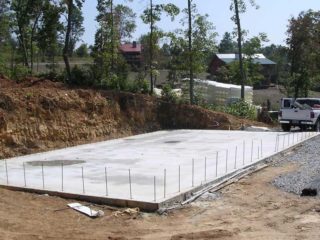
Any design has its own strengths and weaknesses. RC support systems are no exception.
The advantages of constructions proven by practice:
- Relative ease of assembly. It is quite possible to make a high-quality structure with your own hands.
- High strength. The possibility of building heavy multi-storey buildings.
- Versatility. Reinforced concrete foundations can be installed in almost all types of soil, except for silty.
- Long service life. With the correct selection of components, it can be up to 150 years.
Identified disadvantages:
- Large amount of costs. When erecting massive structures, a lot of material is required, the involvement of workers and equipment.
- Long time to cure. To gain full strength, the concrete foundation must stand for 28 days.
- Impossibility or increased complexity of construction in the cold season.
Despite the disadvantages, today reinforced concrete is the most reliable and effective option for arranging support systems for buildings and structures.
Calculation of the foundation and the necessary tools for work
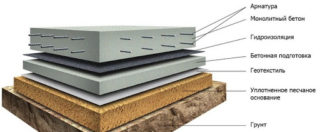
Any job starts with planning. First, a drawing is drawn up, then the calculation of equipment and materials is carried out. The slab foundation is designed with the expectation that with a thickness of 20-40 cm, it will rise 5-10 cm above the ground. The deepening of the tape system depends on the type of soil and the level of its freezing. On heaving soils, the lower point of the base drops by 150 cm and below. On stable soils, a depth of 40-70 cm is sufficient.
You will need the following tools:
- roulette, level;
- shovel;
- concrete mixer;
- Bulgarian;
- ax, hammer;
- screwdriver;
- paint brush;
- scissors, nippers;
- wire twisting device;
- deep vibrator.
Initially, it is recommended to abandon the assembly of the steel frame by welding. From heating, the strength of the metal decreases, the seams quickly rust.
Construction technology
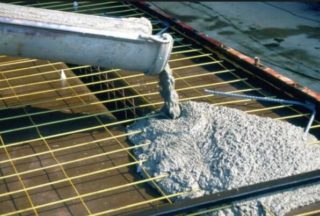
The technology for the construction of a tape reinforced concrete support system has been worked out for centuries and is not particularly complicated.
It is carried out in the following sequence:
- Determining the exact location where the building will be located.
- Carrying out a marking, followed by checking the dimensions of the sides and diagonals.
- Excerpt of the pit with the expectation of installing the formwork.
- Sealing the bottom of a ditch or pit, laying geotextile fibers. It prevents the erosion of the fill.
- Arrangement of a cushion made of sand and gravel. The material is wetted and leveled.
- Formwork installation. A removable or permanent option is selected.
- Reinforcement. The rods and inner frames are tied together with steel wire. Spacers are attached along the edges and bottom.
- Concrete is mixed and poured. This process must be carried out continuously to avoid delamination of the structure.
After the surface has hardened, the foundation is covered with a waterproofing material. Until the moment of gaining full strength, the concrete is daily wetted.

